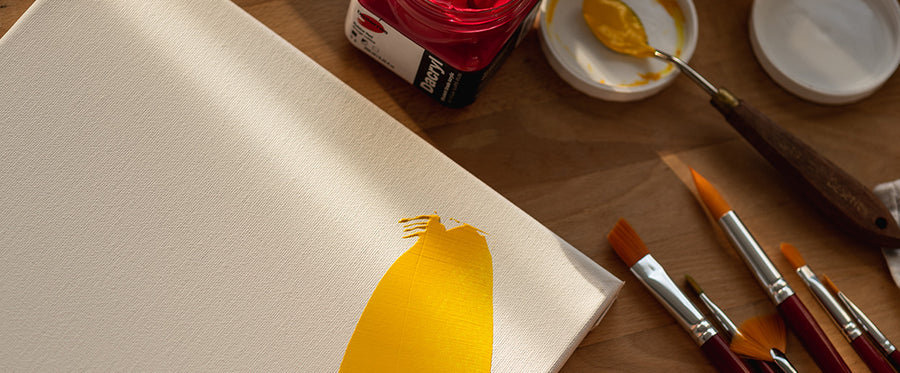By Kyle Sorensen
If you haven’t experimented with this product before—BEWARE—it’s sensational! This line of acrylic paint from Golden is loved for its highly pigmented colour and buttery soft consistency; however, its main feature is its slow drying time. This allows the paint to stay wet on the palette for an extended period of time, which is typically unheard of when speaking about acrylic paint.
If you’re a fan of a soft-bodied and highly workable acrylic paint, then this is the product for you!
TIPS
When using Golden’s Open line, here are a few things to take into consideration:
- This brand stays wet for longer periods of time. If you are looking for a quick-drying acrylic paint that allows for consecutive layering, then this product may not be for you.
- The slower drying time means this paint is more economic. I can use less paint to cover larger areas, which means I, in turn, have less waste.
- If you happen to leave a blob of unused paint on your palette, you’ll find that it is still wet (or open) hours later! If you cover your palette, you can even find that the paint will remain usable for days, or even weeks. No wasted blobs of paint here.
- Be cautious of how thick you apply this product: the thicker the application, the slower the drying time.
MATERIALS

- Apollon-Gotrick Gallery Wood Panel (any size)
- 320-Grit Sandpaper
- Liquitex Transparent Gesso
- Golden Open Acrylic Paints (any colour)
- Golden Retarder
- Winsor & Newton Professional Matte Varnish
- Flat Head Synthetic Paintbrushes (multiple sizes) -> smooth bristles are best for flat and smooth colour application
- Paint Palette
PREPPING YOUR SURFACE

I always say that the key to hard-edge painting comes down to the preparation of your substrate. I have always found that cradled birch panels are the absolute best for this style of painting, as well as a matte gesso. Here’s how I go about preparing my surface for painting:
Step 1
Begin by sanding your Cradled Birch Panel with a lightweight sandpaper: I like to use 220 or 320 grit sandpaper. You can also choose to sand by hand, or you can use what I use, which is a sheet sander. Any brand will typically do; however, I personally like the DeWalt 2.3 amp ¼ Sheet Palm Grip Sander.
Tip: Try to apply an even amount of pressure while sanding to ensure your surface is uniform. I also like to sand with the grain to avoid any nasty splintering.

Step 2
Once your surface has been sanded, it’s time to gesso! White gesso is the typical choice for a lot of artists, but I like to use the Transparent Gesso by Liquitex. It leaves little to no evidence, and still allows the wood grain to shine. I also find that transparent gesso generally allows for a better colour adherence, as compared to white gesso.
Tip: Apply your gesso with a large flat head brush in an even and well-saturated application. Apply too little gesso and your wood panel will appear patchy: apply too much gesso and your wood panel will take much longer to dry.

Step 3
Once you’ve applied a layer of gesso to your wood panel, it’s recommended to allow it to dry and cure for approximately 24 hours. If you’ve got the time on your hands, then definitely follow this advice. If you’re slightly more impatient, you can always try the good ol’ hair dryer trick to speed along the drying process.
Step 4
Now that your gesso has had the time to dry, you need to sand it one last time to get the surface as smooth as possible. A smooth surface is integral for hard-edge painting, especially when using tape. Any minor imperfection or grit in the surface will result in a botched tape pull … every artist’s worst nightmare! To sand the surface for the final time, repeat Step 1, making sure that your surface is smooth to the touch and free of any texture. I like to use a soft-bristled brush to do one last sweep of the surface to remove any dust or debris.

IMAGE TRANSFER
Now that your surface is super smooth, it’s time to get painting…well, just about! For me, the next step in my process is to transfer the digital sketch that I’ve created onto the prepared substrate.
If you’re the type that likes to wing it, all the power to you! You can skip this step. For me, I spend lots of time sketching digitally on a program called Procreate. This is an app that I could not live without, it’s better than any sketchbook I have ever kept.
Once the sketch has been created, I project the image (using a projector) onto the panel and pencil in each line. This will aid me in making sure each line is perfectly straight. Hard-edge painting wouldn’t be the same without perfectly straight lines, now, would it?

PAINTING
Without giving away too much of my “secret sauce”, painting is my absolute favourite part of the process.
Working with Golden’s Open Acrylics is equally satisfying. For the painting process, you’ll see that I work in the following steps:
Step 1
Mask or tape your desired section with any type of painting tape you desire. Because your surface is now a smooth masterpiece, you’ll find that the brand or type of tape you use during this step doesn’t really matter. I like to use a semi-transparent masking tape.
Step 2
Mix your acrylic on your palette to achieve your desired colour, making sure that your colour is evenly mixed.

Step 3
Take your flat head brush and load it up, ensuring it does not have too much paint.
Step 4
Apply the colour to your masked section, working with the grain.
Step 5
If you need a further extended drying time, you can always add in a touch of Golden Retarder. This is especially great for large sections!
Step 6
Allow the paint to dry slightly and remove your masking tape to reveal your perfectly crisp paint edges.

The remainder of the process is on repeat: mask, paint, remove.
Tip: It’s important to remember this isn’t a fast process by any means. It’s a labour of love and cannot be rushed! Take your time to enjoy the process.


VARNISH
Once your painting is complete, it’s important to ensure that the surface is free of any accumulated dust, hair, etc. Then, it’s time to apply a coat (or a few coats) of varnish. I like to use Winsor & Newton’s Professional Matte Varnish. You’ll want to ensure that you are outside or in a well-ventilated space when working with varnish. Also, make sure that you’re wearing a face covering to avoid any inhalation of fumes. Allow your varnish to dry for approximately 24 hours.
And voila, there you have it, Sign your painting (back or front) and enjoy!










